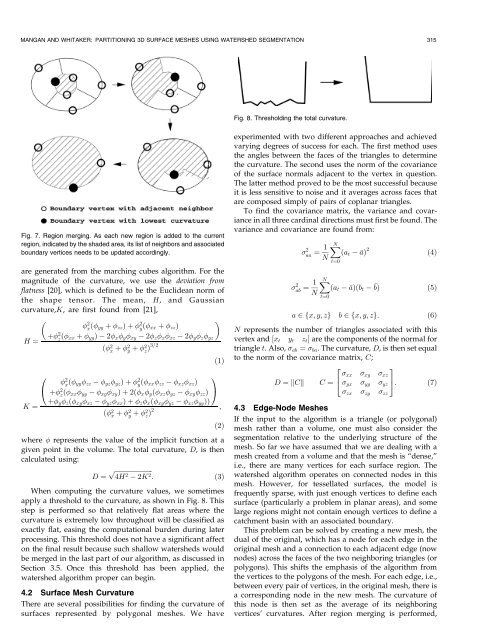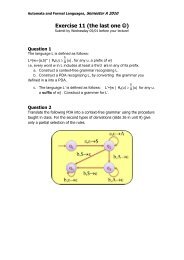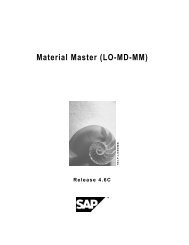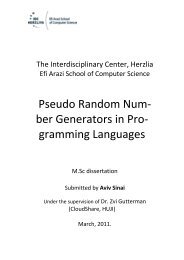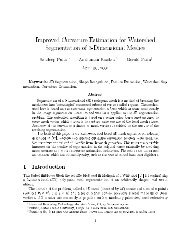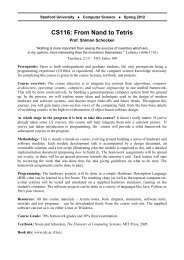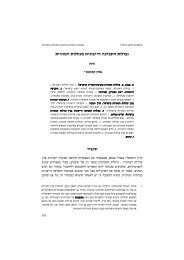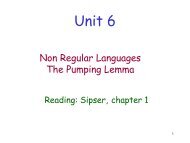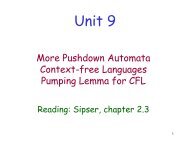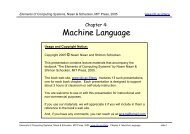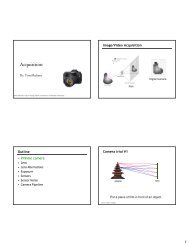Partitioning 3D Surface Meshes Using Watershed Segmentation
Partitioning 3D Surface Meshes Using Watershed Segmentation
Partitioning 3D Surface Meshes Using Watershed Segmentation
You also want an ePaper? Increase the reach of your titles
YUMPU automatically turns print PDFs into web optimized ePapers that Google loves.
MANGAN AND WHITAKER: PARTITIONING <strong>3D</strong> SURFACE MESHES USING WATERSHED SEGMENTATION 315<br />
Fig. 8. Thresholding the total curvature.<br />
Fig. 7. Region merging. As each new region is added to the current<br />
region, indicated by the shaded area, its list of neighbors and associated<br />
boundary vertices needs to be updated accordingly.<br />
are generated from the marching cubes algorithm. For the<br />
magnitude of the curvature, we use the deviation from<br />
flatness [20], which is defined to be the Euclidean norm of<br />
the shape tensor. The mean, H, and Gaussian<br />
curvature,K, are first found from [21],<br />
<br />
2 x … yy ‡ zz †‡ 2 y … <br />
xx ‡ zz †<br />
‡ 2 z<br />
H ˆ<br />
… xx ‡ yy †2 x y xy 2 z x xz 2 y z yz<br />
… 2 x ‡ 2 y ‡ 2 z †3=2<br />
K ˆ<br />
0<br />
2 x … yy zz yz yz †‡ 2 y … 1<br />
xx zz xz xz †<br />
@ ‡ 2 z … xx yy xy xy †‡2… x y … xz yz xy zz † A<br />
‡ y z … xy xz yz xx †‡ z x … xy yz xz yy ††<br />
… 2 x ‡ 2 y ‡ ;<br />
2 z †2<br />
where represents the value of the implicit function at a<br />
given point in the volume. The total curvature, D, is then<br />
calculated using:<br />
p<br />
D ˆ<br />
<br />
4H 2 2K 2 : …3†<br />
When computing the curvature values, we sometimes<br />
apply a threshold to the curvature, as shown in Fig. 8. This<br />
step is performed so that relatively flat areas where the<br />
curvature is extremely low throughout will be classified as<br />
exactly flat, easing the computational burden during later<br />
processing. This threshold does not have a significant affect<br />
on the final result because such shallow watersheds would<br />
be merged in the last part of our algorithm, as discussed in<br />
Section 3.5. Once this threshold has been applied, the<br />
watershed algorithm proper can begin.<br />
4.2 <strong>Surface</strong> Mesh Curvature<br />
There are several possibilities for finding the curvature of<br />
surfaces represented by polygonal meshes. We have<br />
…1†<br />
…2†<br />
experimented with two different approaches and achieved<br />
varying degrees of success for each. The first method uses<br />
the angles between the faces of the triangles to determine<br />
the curvature. The second uses the norm of the covariance<br />
of the surface normals adjacent to the vertex in question.<br />
The latter method proved to be the most successful because<br />
it is less sensitive to noise and it averages across faces that<br />
are composed simply of pairs of coplanar triangles.<br />
To find the covariance matrix, the variance and covariance<br />
in all three cardinal directions must first be found. The<br />
variance and covariance are found from:<br />
2 aa ˆ 1 X N<br />
…a t a† 2<br />
…4†<br />
N<br />
tˆ0<br />
2 ab ˆ 1 X N<br />
…a t a†…b t b†<br />
N<br />
tˆ0<br />
…5†<br />
a 2fx; y; zg b 2fx; y; zg: …6†<br />
N represents the number of triangles associated with this<br />
vertex and ‰x t y t z t Š are the components of the normal for<br />
triangle t. Also, ab ˆ ba . The curvature, D, is then set equal<br />
to the norm of the covariance matrix, C;<br />
2<br />
xx xy<br />
3<br />
xz<br />
D ˆkCk C ˆ 4 yx yy yz<br />
5: …7†<br />
zx zy zz<br />
4.3 Edge-Node <strong>Meshes</strong><br />
If the input to the algorithm is a triangle (or polygonal)<br />
mesh rather than a volume, one must also consider the<br />
segmentation relative to the underlying structure of the<br />
mesh. So far we have assumed that we are dealing with a<br />
mesh created from a volume and that the mesh is ªdense,º<br />
i.e., there are many vertices for each surface region. The<br />
watershed algorithm operates on connected nodes in this<br />
mesh. However, for tessellated surfaces, the model is<br />
frequently sparse, with just enough vertices to define each<br />
surface (particularly a problem in planar areas), and some<br />
large regions might not contain enough vertices to define a<br />
catchment basin with an associated boundary.<br />
This problem can be solved by creating a new mesh, the<br />
dual of the original, which has a node for each edge in the<br />
original mesh and a connection to each adjacent edge (now<br />
nodes) across the faces of the two neighboring triangles (or<br />
polygons). This shifts the emphasis of the algorithm from<br />
the vertices to the polygons of the mesh. For each edge, i.e.,<br />
between every pair of vertices, in the original mesh, there is<br />
a corresponding node in the new mesh. The curvature of<br />
this node is then set as the average of its neighboring<br />
vertices' curvatures. After region merging is performed,


